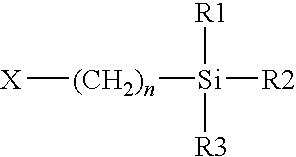Process for producing a multilayer coating
a multi-layer coating and coating technology, applied in the direction of coatings, polyester coatings, layered products, etc., can solve the problems of unsatisfactory cohesion within the water-borne base coat layer itself, lack of satisfactory initial wet adhesion between the individual layers, and similar problems, etc., to achieve excellent high pressure cleaning resistance, excellent wet adhesion, excellent adhesion properties
- Summary
- Abstract
- Description
- Claims
- Application Information
AI Technical Summary
Benefits of technology
Problems solved by technology
Method used
Image
Examples
example 1
Preparation of Primer Compositions
[0146]LE2004, a commercial sanding primer surfacer (from DuPont Refinish), based on a hydroxyl-functional (meth)acrylic copolymer, has been used as base component (hydroxyl component) for the primer (with pigment volume concentration (PVC) of 60, solids content of 70% by weight).
[0147]Desmodur® 3390, a HDI-trimer based polyisocyanate from Bayer has been used as activator (cross-linking agent). The activator has been modified with 9% by weight solids of an epoxy-functional silane of formula (I) (Dynasylan® Glymo from Degussa), relative to the total amount of activator, which corresponds to 4.4% by weight solids of the epoxy-functional silane, relative to the sum of the solids content of the hydroxyl-functional (meth)acrylic copolymer and the polyisocyanate. The non-modified activator, which does not contain the epoxy-functional silane, has been used for comparison (Comp. Activator 1). The activators were formulated with the ingredients shown in Table...
example 2
[0157]Again LE2004, a commercial sanding primer surfacer (from DuPont Refinish), based on a hydroxyl-functional (meth)acrylic copolymer, has been used as base component (hydroxyl component) for the primer (with pigment volume concentration (PVC) of 60, solids content of 70% by weight) and Desmodur® 3390, a HDI-trimer based polyisocyanate from Bayer has been used as activator (cross-linking agent). The primer LE2004 (base component) was activated with activator 2 and activator 3 and the comparative activator 2 (4:1 volume ratio base component: activator) to form primer 2 (PR 2) and primer 3 (PR3) according to the invention and comparative primer 2 (comp. PR 2). The activators were formulated with the ingredients shown in Table 2. The amount of the solvents was adjusted in order to keep the solids (70%) constant.
TABLE 2ExamplesComp.ActivatorActivatorActivator2 (% by2 (% by3 (% byCompositionweight)weight)weight)PolyisocyanateDesmodur ®53.2353.2353.233390 (Bayer)SolventsButylacetate24.5...
PUM
| Property | Measurement | Unit |
|---|---|---|
| glass transition temperatures | aaaaa | aaaaa |
| glass transition temperatures | aaaaa | aaaaa |
| thickness | aaaaa | aaaaa |
Abstract
Description
Claims
Application Information
 Login to View More
Login to View More - R&D
- Intellectual Property
- Life Sciences
- Materials
- Tech Scout
- Unparalleled Data Quality
- Higher Quality Content
- 60% Fewer Hallucinations
Browse by: Latest US Patents, China's latest patents, Technical Efficacy Thesaurus, Application Domain, Technology Topic, Popular Technical Reports.
© 2025 PatSnap. All rights reserved.Legal|Privacy policy|Modern Slavery Act Transparency Statement|Sitemap|About US| Contact US: help@patsnap.com



